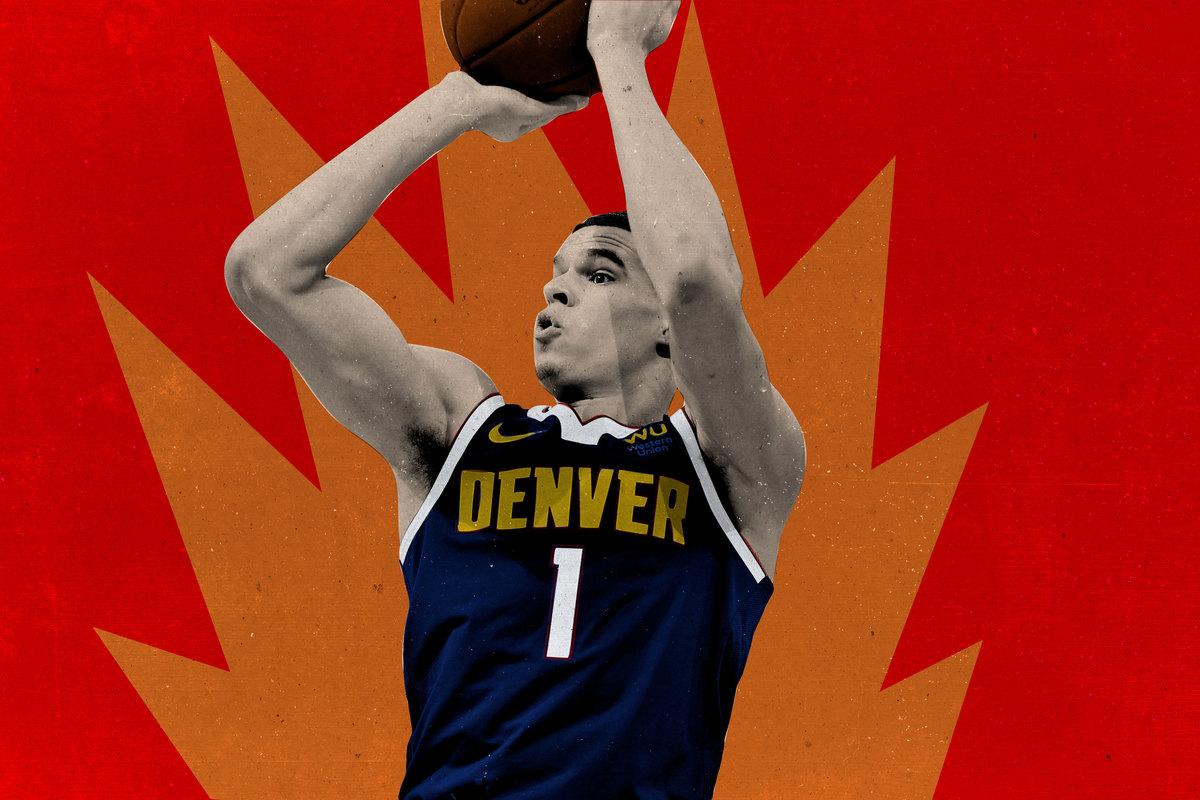Michael Porter Jr. May Be the Future in Denver, but First He Needs to Earn His Spot
After two lost seasons to injury, the Nuggets rookie has flashed the scoring prowess that once made him the top high-school recruit. But until Porter comes of age, the Nuggets are caught between developing a potential star and making a push for the title.
The fans at the Pepsi Center stood when Michael Porter Jr. checked into a regular-season game in Denver for the first time. There were a little over three minutes remaining in an otherwise forgettable 109-89 win over Miami in the second week of the season, but it didn’t feel like garbage time once Porter took off his warm-ups.
The crowd buzzed every time he touched the ball. There were big cheers when Porter scored his first basket, a dunk on an offensive rebound. They grew louder when he came around a double screen and knocked down a pull-up jumper the next time down the floor.
It has been that way for Porter all season, his first in the NBA. Everything he does is an event. The fans in Denver still applaud when he checks in, more than two months after his home debut. Social media goes wild when he strings a few baskets together. Reporters talk to him in every city.
“I try not to put too much in my head,” Porter told me this week. “I’m trying to do what I can to help the team win right now.”
Porter was more myth than player before the season. He was the next big thing coming out of high school—a wing with the size of a center, unlimited shooting range, and the ability to dunk in traffic. But a back surgery limited him to 53 minutes as a freshman at Missouri, causing him to slide to no. 14 overall in the 2018 draft, and another kept him out his entire rookie season. All Denver fans had to go on were YouTube clips of him dunking on overmatched teenagers:
Porter has been one of the most highly touted prospects in the country since he was a freshman in high school. The years of hype followed by the injuries have created a situation that would barely have seemed imaginable a few generations ago: His rookie season has the feel of a comeback.
“I think people are just excited to see me back on the floor,” he said. “It’s cool. I appreciate the love.”
But even once he was healthy, it took Porter time to crack Denver’s crowded rotation. He received nine DNP-CDs in the first six weeks of the season, and began playing consistently only at the start of December. He has been an offensive machine whenever he has been on the floor this season, averaging 19.4 points on 53.5 percent shooting, 9.6 rebounds, and 1.3 blocks per 36 minutes of playing time.
There are still nights when Porter looks like an overmatched rookie. But there are others when his potential seems limitless. He had 19 points on 8-of-10 shooting in his only career start in a late December game against the Kings and a career-high 25 points on 11-of-12 shooting against the Pacers a few nights later.
Porter has already shown enough to be considered a huge part of the Nuggets’ future. What coach Michael Malone and the rest of the Denver organization have to figure out in the run-up to the trade deadline is how much the 21-year-old can help them win now.
“I tell people all the time—he’s going to be a special player. I’ve seen all the writing on the wall. I’ve seen him do it in games now at a high, high level,” Malone said. “He just has to stay with it. It’s not going to happen overnight.”
A few minutes into the Sacramento game, Nikola Jokic was handling the ball at the top of the key when he saw Porter streaking to the paint with a step on De’Aaron Fox. So the 7-footer (Jokic) threw a pass to his 6-foot-10 teammate (Porter) over a 6-foot-3 defender (Fox). It was like watching a quarterback throw the ball to a tight end in a spot where only he could catch it.
Denver runs one of the most unorthodox offenses in the NBA. Jokic, a lumbering point center, is the hub around which the other four players revolve, constantly moving the ball whenever he sees an opening and then counting on his teammates to get it back to him.
Playing in that type of system is new for Porter. He has spent most of his life holding the ball and hunting for mismatches. He told me that he was allowed to shoot as soon as he crossed half-court in high school. He’s never had to spot up and wait for someone else to give the ball to him.
A lot of young perimeter players struggle with that transition. Porter makes it look easy. He’s a natural cutter whose size makes it easy for him to get open, and he has great touch in the lane:
The strengths of his game and the way that he’s being used have combined to create a player with a hyperefficient shooting profile: “I either catch it and I can shoot a wide-open 3 or they close out to me and I can drive and get to the hoop. Or I’m cutting to the rim,” he said.
Michael Porter Jr. Shot Chart
Playing with Jokic may be the best thing that could have happened to Porter. As great as he was in high school, he was a streaky shooter who rarely moved the ball. The best wings in the NBA also have to be elite playmakers. Porter is averaging 0.5 assists and 0.8 turnovers per game this season. He’s more comfortable hunting for his own shot than reading the floor.
Jokic makes life easier for everyone around him because they can focus on scoring and let him run the offense. He’s a more willing passer than most guards. He averages far more touches per game than anyone else in Denver, but he usually gives up the ball as soon as he has it. Look at how small his total time of possession is in comparison with the other players on top of the touches leaderboard this season:
Nikola Jokic Passing
Because he’s such an efficient receiver, Porter is the perfect complement to a passer who spreads the ball around. He’s no. 12 in the league in average points per touch (0.424), behind only shooting specialists like JJ Redick and Troy Daniels, and elite scorers like James Harden and Devin Booker.
Jokic finds Gary Harris, a 6-foot-4 shooting guard, for open shots on cuts every game. Imagine what he can do with a 6-foot-10 guy in that role. Jokic can throw Porter alley-oops the whole game.
“It’s an easy flow for our offense where everybody touches the ball. It’s not like you are watching one or two guys iso the whole game,” Nuggets backup point guard Monte Morris told me this week. “I always tell [Porter], just go out there and hoop and get stops with us and the offense will take care of itself.”
The pairing of Porter and Jokic, who is still just 24, should only grow deadlier in the years to come. Despite what he’s flashed thus far, Porter told me he still doesn’t feel like himself. It’s not as easy for him to create separation off the dribble. And he’s not dunking on people.
“It is [frustrating] but at the same time I’m thankful that I can play. I’m getting back to it. I just feel like there’s a whole lot more coming. My injury was complex. It can take years to fully get back to normal. But I feel like I’m on the way,” he said. “I’m still healing. I’m not even close to where I’ll be at. But I don’t have any pain, which is amazing. I’m not too sore after games or anything like that. That’s a real positive. I feel like I’m continuing to heal. Every month. Every week.”
Malone’s eyes light up when you ask him about defense. There are a lot of coaches who look for ways to answer questions in as few words as possible, but Malone always seems to have more to say about that end of the floor.
The son of longtime NBA coach Brendan Malone, Michael Malone brings an old-school mentality to his teams. He wants tough players willing to throw their bodies around. It took Denver, a team built around skill and shooting, a long time to adopt his mentality. The Nuggets were ranked in the 20s in the NBA on defense in each of Malone’s first three seasons. They were no. 10 last season and are no. 12 this season. Given all the hard work he’s put in establishing Denver’s defense, Malone won’t play a rookie who can’t execute a role in his scheme.
“I think [Porter] is learning nothing’s going to be given to him. He’s got to earn everything and I really appreciate his patience,” Malone said. “I think that it’s the right thing. A lot of times when players are just given things, I think that can really harm their development and their success.”
Porter was once considered a future top-three pick, but on a deep Denver team that finished second in the West without him last season, he has had to earn his spot. He’s no. 11 on the team in total minutes this season (304) and no. 10 in shot attempts (127). His only job is to get out of the way and not mess things up. He doesn’t have to make many good plays; he just can’t make bad ones.
“I have to do the small things. Learn the small details,” Porter said. “Be on time for my rotations. Not have to think as much. Really know where I’m going. Know the other team’s personnel. Know who I’m guarding, what they like to do.”
But just because a thing is small doesn’t make it easy. Morris, a third-year guard from Iowa State, went through a similar process with Malone. He’s a savvy point guard who was one of the leaders in assist-to-turnover ratio in each of his four seasons in college, but even he sat for most of his rookie season.
“It’s just the speed. The terminology is different. But the speed for sure,” Morris said about the challenges of learning NBA defense. “So if you are late on a rotation, the rotation is wrong.”
There were several plays in Wednesday’s win against Dallas where Porter was a split-second late, and it made all the difference. In the first sequence in this clip, Seth Curry gets around Morris and drives toward the rim. Porter, as the help-side defender, doesn’t react quickly enough, allowing Curry to float a teardrop over him. In the second, there’s a miscommunication between Porter and Juancho Hernangómez about who should pick up Maxi Kleber in the corner. Porter quickly realizes that Kleber is open, but it’s already too late for him to even contest the shot:
Playing defense in the NBA has never been harder. The Mavs are the perfect example of why: They have the most efficient offense in NBA history because of their ability to spread the floor around a gifted playmaker like Luka Doncic. All five defenders have to play on a string to cover that much ground. Even the smallest hesitation by one can lead to an open shot.
Malone said Porter will get better with experience, but there are costs to letting him learn on the job. You won’t see his failures to recognize an open shooter in the box score, but you will see it in his advanced numbers. With Porter on the floor, the Nuggets have a worse defensive rating than with any other rotation player. Look at the difference between him and the other three wings coming off their bench:
Nuggets Wings’ Defensive Ratings
Porter can score, but it doesn’t matter if he gives all those points back on defense. He could be an X factor for Denver in the playoffs. But he could also slip out of the rotation entirely.
The Nuggets are again second in the West, but the Clippers, Rockets, and Jazz are all within one game of them. All three would be tough outs in the playoffs, as would the Mavs, who are three games back at no. 6. Malone won’t be able to give a defensive liability a long leash.
Denver’s bench was standing and cheering for Porter by the end of his barrage in the second half against Indiana last week, where he had 18 points in 14 minutes. He had everything going—getting into the lane, playing out of the post, and even knocking down a step-back 3. These were the kind of games that made him the top prospect in the country in high school:
Everyone around the team that I talked to was thrilled for Porter’s success, especially given how hard he worked during his recovery. But the situation must be awkward for some of his teammates: The downside of having one of the deepest teams in the NBA is that a lot of good players don’t play.
“That’s one of my challenges—finding ways to help that bench unit out,” Malone said. “We have gone with different lineups, gone with different rotations, because in my opinion, that group has been up and down.”
The first three players off the Denver bench are Morris, Mason Plumlee, and Jerami Grant, a hyperathletic forward whom it acquired from Oklahoma City this summer for a first-round pick. That leaves Porter, Malik Beasley, Torrey Craig, and Hernangómez fighting for minutes.
Beasley looked like a rising star last season, averaging 11.3 points per game and shooting 40.2 percent from 3 on 5.0 attempts per game. He’s an athletic wing who can stretch the floor, guard multiple positions, and score off the dribble. Beasley went for 35 points in a game against Houston last season and had 11 other games with at least 20. But those opportunities have dried up this season. He’s received five DNP-CDs in the last month.
According to Bobby Marks of ESPN, the Nuggets offered Beasley a three-year, $30 million extension on his rookie deal last summer, but he turned it down to enter restricted free agency this offseason. Beasley, who is still only 23, would make sense for any of the five young teams with significant cap space this summer: Atlanta, Charlotte, Cleveland, Memphis, and New York.
Hernangómez, who will also enter restricted free agency this summer, is an athletic, 6-foot-9 combo forward with 3-point range who has shown promise when he’s gotten to play. Craig is a veteran defensive specialist who started 11 playoff games for the Nuggets last season.
Shams Charania of The Athletic reported three weeks ago that the Nuggets were willing to listen to trade offers for Beasley and Hernangómez. Both will probably be gone in the offseason—Porter has made them expendable. The Nuggets can’t give a long-term contract to someone who doesn’t play much, and doing so would likely put them in the luxury tax, which they’ve been unwilling to do of late.
That roster flexibility is where Porter could help Denver the most this season. With its surplus of young players and Plumlee’s expiring contract ($14 million), the Nuggets are one of the most interesting teams heading into the February 6 trade deadline.
There are a number of directions they could go. The most intriguing option is Andre Iguodala, who has sat out all season while waiting for Memphis to trade him. The Grizzlies might not get a better offer than Beasley and Plumlee. Beasley’s 3-and-D ability would be a perfect long-term fit next to Ja Morant and Jaren Jackson Jr., while Plumlee would come off the books in the offseason.
Iguodala, who spent one season in Denver before going to Golden State, would be the perfect sixth man for the Nuggets—a veteran wing with the size and savvy to defend LeBron James, Kawhi Leonard, and James Harden in the playoffs. Porter, given all that he still needs to figure out in the NBA, probably isn’t the missing piece for the Nuggets this season. But he could help them acquire that player.
The good news for Denver, no matter what it decides to do, is that it doesn’t have to go all in this season. Its run is just beginning. Jokic’s game doesn’t rely on athleticism, so he should be an elite player for the next decade. The goal should be to find as many long athletes with size and skill to put around him as possible.
Porter may take a few years to develop, but he could be the most important step on that path. “I’m going to have a long career,” Porter said. “All those expectations and where I want to be—that will happen down the road.”

